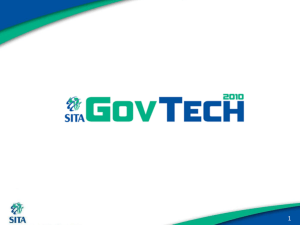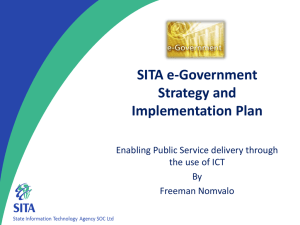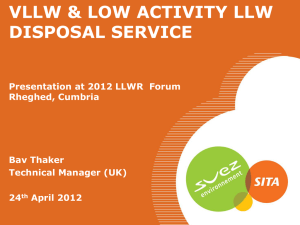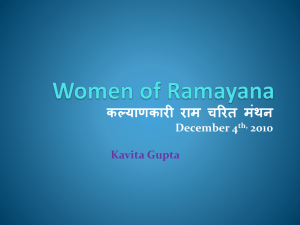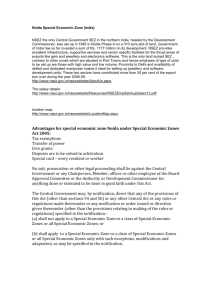Department of Communications - Parliamentary Monitoring Group
advertisement
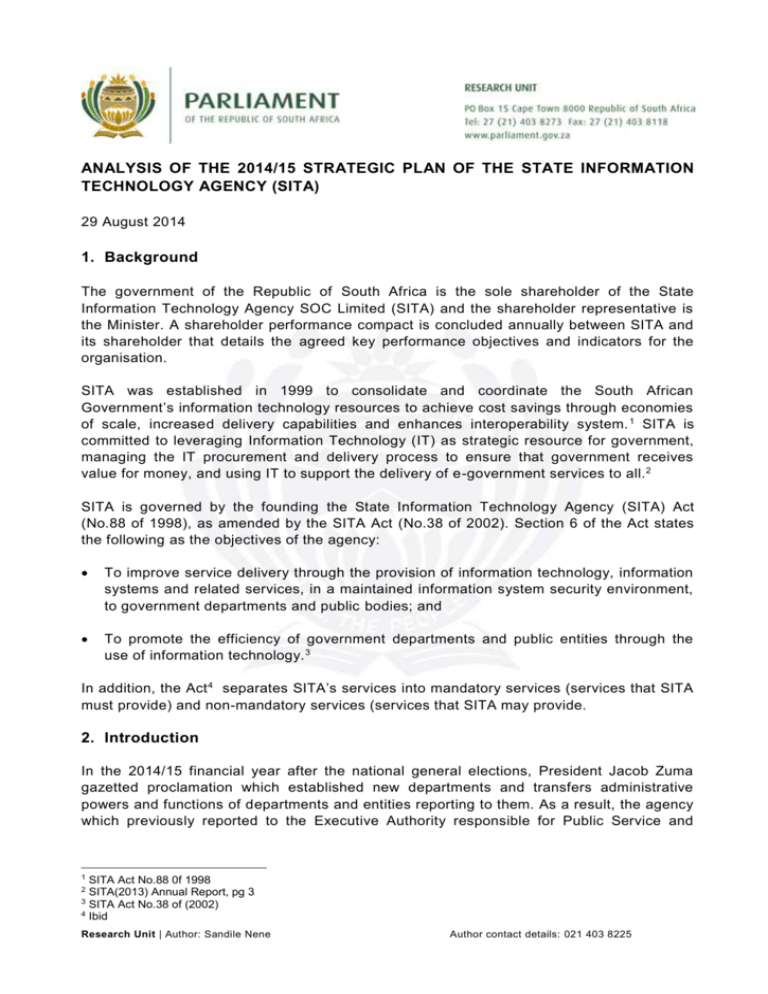
ANALYSIS OF THE 2014/15 STRATEGIC PLAN OF THE STATE INFORMATION TECHNOLOGY AGENCY (SITA) 29 August 2014 1. Background The government of the Republic of South Africa is the sole shareholder of the State Information Technology Agency SOC Limited (SITA) and the shareholder representative is the Minister. A shareholder performance compact is concluded annually between SITA and its shareholder that details the agreed key performance objectives and indicators for the organisation. SITA was established in 1999 to consolidate and coordinate the South African Government’s information technology resources to achieve cost savings through economies of scale, increased delivery capabilities and enhances interoperability system. 1 SITA is committed to leveraging Information Technology (IT) as strategic resource for government, managing the IT procurement and delivery process to ensure that government receives value for money, and using IT to support the delivery of e-government services to all. 2 SITA is governed by the founding the State Information Technology Agency (SITA) Act (No.88 of 1998), as amended by the SITA Act (No.38 of 2002). Section 6 of the Act states the following as the objectives of the agency: To improve service delivery through the provision of information technology, information systems and related services, in a maintained information system security environment, to government departments and public bodies; and To promote the efficiency of government departments and public entities through the use of information technology. 3 In addition, the Act 4 separates SITA’s services into mandatory services (services that SITA must provide) and non-mandatory services (services that SITA may provide. 2. Introduction In the 2014/15 financial year after the national general elections, President Jacob Zuma gazetted proclamation which established new departments and transfers administrative powers and functions of departments and entities reporting to them. As a result, the agency which previously reported to the Executive Authority responsible for Public Service and 1 SITA Act No.88 0f 1998 SITA(2013) Annual Report, pg 3 3 SITA Act No.38 of (2002) 4 Ibid 2 Research Unit | Author: Sandile Nene Author contact details: 021 403 8225 Administration now reports to the Executive Authority responsible for Telecommunications and Postal Services. 5 A research paper entitled: “Driving e-Government success in South Africa” noted that: “egovernment in South Africa still finds itself perched between performance and promise, as its full potential is still to be experienced. The research also f ound that the face and character of the ICT landscape in the country has radically changed over the last decade. 6 It is imperative to note the role that e-government plays, now and in the future especially in the digital era, as well as the in context of the world moving towards 2015, the date set for reaching the Millennium Development Goals (MDGs). Inherent in this paradigm is a focus on pivotal linkages among public institutions, such that development challenges can be met with a concerted and coordinated effort that incorporates the environmental dimension in development planning at every stage. The role of the government is once again being redefined to reform the governance systems through which services are delivered in a way that maximises development and minimizes natural resource degradation. By its own account, SITA has by and large failed to achieve the objectives of the ‘SITA Today and SITA Tomorrow Phases’ of the Turnaround implementation during the 2010 -13 financial years. 7 The main focus was to identify 7 key challenges (service delivery, internal operations, weakness in procurement, pricing and value add, leadership, ICT sector and Falling ICT ranking) that impede SITA from carrying its functions. Notwithstanding the above, some of the information systems provided and maintained by SITA includes Persal which pays public servants; Basic Accounting System (BAS) which pays public service bills and logis which manages assets. SITA is also involved in providing information system to 38 departments from management systems (automated fingerprints identification (AFIS) for criminal and non-criminal-related searches (firearm licences, behavioural certificate etc.) passport transaction storage, the National Population Register, or the matric examination results system. In addition, the agency also recorded a saving of R263 million through preferential agreements negotiated with suppliers. 8 Whilst these achievements are applauded, however, the agency has been rocked by continuous leadership instability at all levels, which include resignation of board members, Chief Executive Officers and executive levels changing all the time illustrated by the following issues: In 2012/13 Cabinet appointed the current six Board members, following a previous ruling that saw the rest of the Board take voluntary leave of absence; 5 Government Gazette no. 37839 Mtimunye, M. (2009) 7 In March 2010 Minister of Public Service and Administration (MPSA) adopted a Turnaround Framework for SITA, recognising that a decade of the formation of the agency, the agency was still in many crises. 8 SITA(2013) Annual Report, pg 3 6 2 Research unit | 2014 Analysis of SITA Strategic Plan The initial decision was precipitated by the Presidential appointment of the Special Investigation Unit (SIU) to investigate allegations of corruption, maladministration and fraud in SITA 3. Importance of e-Governance and SITA’s Mandate in Government The steady diffusion of information and communication technologies and the bridging of the digital divide can help empower all stakeholders to translate commitments into action. The evidence base for the latter is strengthened by recent progress in e-government in a growing number of countries where citizens are both users and co-producers of public services. According to the 2012 United Nations e-Government Survey entitled “E-Government for the people today”, powerful new technologies can be used to advance sustainable development for all people across the world while including them in the process. In particular, e government can be an engine of development for the people. In delivering e -government for the people, public services are designed to be responsive, citizen centric and socially inclusive. Governments also engage citizens through participatory service delivery processes. 9 The increasing role of e-government in promoting inclusive and participatory development has also gone hand-in-hand with the growing demands for transparency and accountability in all regions of the world. E-government has strongly shifted expectations of what governments can and should do, using modern information and communication technologies, to strengthen public service and advance equitable, people-centred development. 10 Progress in online service delivery continues in most countries around the world. The United Nations E-Government Survey 2012 found that many governments have put in place e-government initiatives and information and communication technologies applications for the people to further enhance public sector efficiencies and streamline governance systems to support sustainable development. 11 Among the e-government leaders, innovative technology solutions have gained special recognition as the means to revitalise lagging economic and social sectors. The overall conclusion that emerges from the 2012 Survey in today’s recessionary world climate is that while it is important to continue with service delivery, governments must increasingly begin to rethink in terms of e-government and egovernance placing greater emphasis on institutional linkages between and among the tiered government structures in a bid to create synergy for inclusive sustainable development. 9 Zukang, S.(2012) Ibid 11 ibid 10 3 Research unit | 2014 Analysis of SITA Strategic Plan 4. Understanding E-Government and E-Government Services Proper service delivery is vital for the survival of a modern democracy or government. Access to government information by citizens and organisations is therefore a fundamental ingredient in effective government. With ICTs having taken centre stage in the present information era, this access is increasingly and perhaps optimally made possible via electronic services (e-services). 12 As a field of research, e-government and its services have been investigated by scholars from various fields (e.g. Library and Information Science, Information Systems, Computer Science, Public Management, etc.) as well as by many specialists. This has resulted in numerous definitions of the term. The International Journal of Public Information Systems on E-government notes that “E-government remains in its exploratory stages and is consequently difficult to accurately define. 13 Clearly, e-government thus refers to the use, by government agencies, of information technologies (such as Wide Area Networks (WANs), the Internet, and mobile technology) to extend its services to its citizens, businesses, and within the government itself. 14 Egovernment is therefore about the use of digital ICTs for the delivery of government information, programs and services to citizens. Another research paper entitled; “E-Government in Africa: Prospects, challenges and practices” lists these contemporary technologies to include the World Wide Web, e Services, IP-centric technologies, and mobile technologies. 15 E-service or e-service delivery thus shows a government’s willingness to provide services to its citizens in the quickest and best possible way. Traditionally, these services were delivered pers onally by visiting a public office. This type of service, which exists in cities, is not easily available in rural areas where transport is poor and roads can be inaccessible. Where practical, services are now increasingly being delivered electronically to citizens at home and at school without them having to physically visit government offices or buildings. 16 Government e-services are particularly important in rural areas, and the failure to roll out infrastructure for e-government in rural areas has been identified as a major obstacle to attaining government e-services in the developing world, including South Africa. This divide between the ‘e-haves’ and ‘have nots’ is more commonly referred to as the digital divide. 17 In a research paper Harfouch identifies a new form of digital divide - the e-services divide resulting from three types of inequalities: 12 Mutula, S.M. (2010 Löfstedt, U. (2005). 14 Kreutz, M.(2007). 15 Kitaw, Y. (2006 16 Ibid 17 Riley, T.B. (2003). 13 4 Research unit | 2014 Analysis of SITA Strategic Plan Inequality in access to ICTs and to e-services, called the “e-access divide”, Inequality in the ability to use ICT and e-services among those who have access, called the “e-skills divide”, and Inequality between those who accept e-services and those who do not, called the “eservices acceptance divide”. 5. Overview of E-Government Services in South Africa Various arms of the South African Government have embarked on a number of egovernment programmes, for example, the Batho Pele portal, SARS e-filing, the e-Natis system, electronic processing of grant applications from remote sites, and a large number of departmental information websites. Analysts and researchers consider the state of egovernment in South Africa to be at rudimentary stages. 18 There are various factors which collectively contribute to such an assessment. Amongst these, key factors relate to a lack of a clear strategy to facilitate uptake and adoption of e-government services, as well as a lack of evaluation frameworks to assess expectations of citizens who are one of the primary user groups of these services. The above shows that something is being done with respect to e government service provision in South Africa, even though it is still in its rudimentary stages. The problem is that the existing e-government services are generally lacking an overall strategy. 19 While urban-based citizens tend to enjoy limitless access to information, the same cannot be said about the rural poor. In some cases, the rich and the poor live side by side, for example in commercial farming communities. An argument regularly raised against global measures of e-government is that they do not consider what happens at a local level and therefore sometimes misinterpret the situation on the ground. The comments by the Department of Public Service and Administration (DPSA), quoted in Moyo’s 2011 article entitled “Depoliticize e-govt agenda, South Africa told”, note that SA still remains holed in the first stage of maturity of e-government. The recently dissolved PNC concurs, stating that South Africa remains at stage one of a three stage level of service maturity. The programme suggested that the success of e-government initiatives is best measured by the proportion of a country's population that has access to government services. 20 The fact that a large part of South Africa’s population is rural-based and has minimal access to e-government services means that as a country, South Africa falls short of the criteria proposed by Ngcakani above. A notable contrast she raises is that citizen-based egovernment initiatives in SA are currently formalized and governed at national level, when in fact the most essential services are accessed by the ordinary citizen at grassroots or the municipal level of government. This increases the chances of failure of achieving e governance and of e-government services reaching the people because they operate at a 18 Nkomo, N. (2011) Ibid 20 Mutula, S.M. (2010). 19 5 Research unit | 2014 Analysis of SITA Strategic Plan level that is too far removed from the people. There is therefore an urgent need to examine e-government service delivery at local level. A 2012 research paper “Entitled e-government in South Africa” found that, in many of South Africa’s State of the Nation Addresses and Imbizos where government at various levels meet to plan and/or present their plans to the people - e-government services are always mentioned either directly or surreptitiously. E-government can be implied without mentioning the term ‘e-government’ itself. For instance the 2012 State of the Nation Address, President Jacob Zuma spoke of the government’s plan to embark on a massive infrastructure drive. 21 The government has identified this infrastructure to be the backbone of job creation and service delivery. The infrastructure in question consists not only of buildings, dams, bridges and roads, but also of networks. The implementation of e-government in developing countries can lead to a system where the greatest benefits from public online services will accrue to persons of high socio-economic status and education that may use their resources to employ the online services sooner and more productively than their less privileged peers. It is therefore important to check whether the same socio -economic factors are not hampering progress, especially as they (socio-economic factors) manifest between rural and urban citizens. 22 6. Overview and Analysis of the 2014/15 SITA Core Programmes SITA’s strategic drivers are implemented through the six following key programmes: Programme 1: Procurement The aim of the programme is to address all issues relating to delayed procurement turnaround times, removing customer pain points, and transformation the procurement organisation Issue for Consideration: It is imperative that SITA shares with Parliament success in IT procurement that resulted in procuring of goods and services at a lower cost than any single department or entity could do on their own given the constant challenges around procurement and supply chain management of this agency. Programme 2: Service delivery The aim of the programme is to provide high quality IT services to enable government to deliver efficient and convenient services through the use of ICT 21 22 Kaisara, G. and Pather, S. (2012) Ibid 6 Research unit | 2014 Analysis of SITA Strategic Plan Issue for Consideration: Who is responsible for coordination and sharing between government spheres’ data centre facilities, that SITA says has resulted in duplication and fragmentation? The current SITA strategic plan notes that ‘SITA as a custodian of government data has to be at the forefront of the defence against ICT security threats. 23 Government, through an initial process of the Department of Telecommunications and Postal Services and later through the Justice and Constitutional Cluster, developed or is in the process of developing the Cybersecurity legislation, what has been the active role of SITA in this regard? Programme 3: Infrastructure The programme optimise the provision of SITA’s IT infrastructure services in order to increase availability, flexibility, scalability, predictability and security According to SITA’s 2014/15 financial year, the last mile connectivity provides insufficient bandwidth and almost 70% of the last mile connections are below 1Mbps. 24 The National Broadband Policy was published by the Telecommunications and Postal Services department and the Broadband Council has been established. This is in keeping with President Jacob Zuma’s 2013 State of the Nation Address pronouncement that the country will have 100% broadband by 2020. 25 Issues for Consideration: What has been the role of SITA in all these broadband policy developments? Which is and what is the name of the single service provide that dominates the core and last mile connectivity in South Africa? Why is SITA unable to fulfil the demand for DR services by national and provi ncial government customers as compelled by the AGSA? Programme 4: Financial sustainability 23 SITA(2014)pg 27 SITA(2014)pg 26 25 Zuma, J.(2013) 24 7 Research unit | 2014 Analysis of SITA Strategic Plan This programme ensures an effective and efficient financial management and ensures financial growth and stability Programme 5: Organisation The programme seeks to build and maintain organisational capability to enable SITA to achieve its strategic imperatives and becomes an employer of choice within the ICT industry. The agency has Deputy Chief Executive Officer position within its structure, however, it could be argued that perhaps a better suited position ought to have been that of the Chief Operations Officer (COO). It is also strange that the Company Secretary reports to the Chief Executive Officer (CEO) as per the current structure whereas the Companies Act26 dictates that this position reports to the Board. To this end, section84 (1)(c)(i) of the companies Act 27 requires companies to appoint a company secretary and an auditor; and to establish an audit committee. Furthermore section 66 of the Act stipulates that a company secretary must be a permanent resident in South Africa and have requisite knowledge and experience to act as such, and is accountable to the Board. Issues for Consideration: The Office of the CEO appears to be bloated with Project Management Office, as well as the proposed additional subsidiary that will comprise ‘consultants or non-SITA team’. In reality, how will this structure work? Does SITA have a Human Resource succession plan to deal with the loss of scare skills? The ICT Academy presumably exists in structure only. Is this not a duplication of Ikamva National E-skills Institute/ if not, why not and how would the areas of overlap be addressed? The Official Sign-off of the SITA’s Annual Performance Plan (APP) contains the details of an official responsible for planning as required by National Treasury, howe ver this is contradicted by the official sign-off of the Strategic Plan. How did this come about and why are all the two documents written confidential and restricted respectivel y, given the fact that these are public documents? 26 27 Companies Act No. 71 of 2008 Ibid 8 Research unit | 2014 Analysis of SITA Strategic Plan Since the agency’s establishment, the previous Executive Authority responsible for SITA’s portfolio created three key roles in ensuring delivery of ICT in government and the 2014 proclamation’s implication means that such portfolio must also be transferred to the Department of Telecommunications and Postal Services and these are: The Government Chief Information Technology Officer (GCIO) and the Office of the OGCIO which was responsible for development of IT/Information Management (IM) policies, regulations, standards and norms. The OGCIO is responsible for oversight, e -Government project coordination and management and Secretariat function of the Government Information Technology Officers Council (GITOC) must be transferred to the DPTS with speed. Government Information Technology Officer (GITO) Council facilitates change in government by introducing an effective information management strategy and consolidated information technology system that would be accessible to all government. The GITO was previously tasked with developing a Government Wide ICT Strategy. Issue for Consideration: The findings of the strategy must be submitted to and form part of both the ICT Policy Panel Review of the Department of Telecommunications and Postal Services as well its Vision 2020 State Information Technology Agency Contract to SITA’s claims of schools connectivity, the agency can do this as part of its Corporate Social Responsibility not as a core function as it does not have a mandate to perform this function. Programme 6: Governance and Administration This programme provides leadership, strategic management, governance, risk and resource management in line with government accepted norms and standards 7. Additional Issues for Consideration by Parliament In Understanding the Mandate and Further Challenges Faced by SITA Human Capital Management and budget- During the 2011/12 financial year, the employee cost was at 74 per cent and in the 2012/13 financial year, it was reduced to 68 per cent of a staff complement of 2 740 employees. However, SITA is still using labour brokers; High turnover of the Chief Executive Officers and executives; Dissatisfied customers 9 Research unit | 2014 Analysis of SITA Strategic Plan Due to internal staff issues, it had become evident that ‘SITA’s Siyashesha programme’ introduced by the board was not inadequate to deal with challenges facing the agency. the largest customers are threatening to withdraw from organisation and employees are demotivated due to the protracted organisational restructuring process. The agency was still struggling to attract suitably qualified black females into Senior Management Services; and the agency did not meet the Employment Equity Act provisions in the staff complement whose EEA target was 64% but only ac hieved 57 % and was short of meeting target of employing 2 per cent of people with disabilities; The Audit Committee appears to be chaired the existing Board member which is contrary to the provisions of the PFMA which requires an external chairperson; SITA has an Internal Audit forensic capability to conduct forensic investigations on the request of management or Board but there are still a number of irregularities; The agency failed to make payments to its creditors within the 30 days target and instead has an average of 70, 048 days; Payments to Small Medium and Micro Enterprises (SMMEs) within 21 days was not achieved. The Supply Chain Management turnaround strategy of 90 days in bids has in the past actually translated into 127, 55 days The agency failed to adhere to the implementation of National Treasury’s four Integrated Financial Management System(IFMS) modules(this programme has been planned to have a 4-year build phase(the following issues are still in progress-(a)Supply Chain Management- Integration to Master data(b) Human Resource Management: Payroll product development(c) Financial Management; FinCore product development; and (d) Business Intelligence: BI legacy replacement In addition, the payroll module, has to date-been unsuccessfully advertised three times and there appears to be no tender process currently under way for the payroll module. The IFMS project is critical to government’s ambition to run a clean, corruption -free administration. To this end, the Auditor-General (AG) noted “The public sector departments and public entities are heavily reliant on IT systems to perform their statutory financial management, reporting and administrative functions.” 28 The AG further noted the role of the IFMS project in the results of the public sector. “Due to prolonged contract negotiations, the lack of full capacity at SITA, underutilisation of the approved budget, delayed project deliverables, an ineffective risk management process, non-adherence to timelines and ineffective oversight, the IFMS was not fully implemented and rolled out to government as envisaged.’29 Further, the AGSA noted that “only the asset register, HR and procurement modules were rolled out at specific lead sites, while the payroll, finance, inventory management and business intelligence modules were still under development. 30 28 AGSA(2013) Portfolio Committee on Standing Accounts 29 Ibid 30 AGSA(2013) 10 Research unit | 2014 Analysis of SITA Strategic Plan The agency also failed in its attempt to implement the ICT academy; It also failed to implement critical path milestones for the year due to a legal challenges to the bid and was waiting for guidance from South African Revenue Service and National Treasury. Accounting and Auditing Concerns of SITA (own findings) The company did not timeously establish a social and ethics committee, as required by Regulation 43 of the Companies Act of 2008; SITA accumulated surpluses without National Treasury approval contriving section 53(3) of the PFMA; Investigations into allegations of financial misconduct against officials were, in some instances, not instituted within 30 days of discovery, as required Treasury Regulation 33.1.2 Auditor General of South Africa SITA is empowered by the Act to facilitate procurement process strict in terms of the prescribed legislation. On several occasions, the AG identified instances of noncompliance with laws and regulations pertaining to the procurement process, contract management and adherence to internal control. These non-compliance matters could have caused modifications to government departments and other public bodies’ auditors’ reports Planned targets Of the 30 targets planned for the 2012/13 financial years, only 15 were not achieved Procurement and contract management Contracts were awarded to bidders based on preference points that were not allocated in accordance with the requirements of the Preferential Procurement Policy Framework Act (No.5 of 2000) and its Regulations. Bids included both preference points scoring methods; The existence of evergreen contracts for the procurement of goods and services above R500.000 results in non-compliance with Treasury Regulations 16A3.1.; The entity evaluated suppliers not on bid closing register. Goods, works or services were not procured through a procurement process which is fair, equitable, transparent and competitive as required by section 51(1) of the PFMA; The request for bids document did not include the General Conditions of Contracts as required by National Treasury Regulation 16A.6.3(a). Internal Controls-Leadership 11 Research unit | 2014 Analysis of SITA Strategic Plan The agency’s monitoring of the effectiveness of internal controls over financial reporting and compliance with laws and regulations were inadequate and resulted in material adjusted to the financial statements and non-compliance with laws and regulations Financial and performance management The entity did not prepare regular, accurate and complete financial and per formance reports that were supported and evidenced by reliable information; The entity did not implement proper record keeping to ensure that complete, relevant and accurate information was accessible and available to support financial and performance reporting; The entity did not monitor compliance with laws and regulations The AG also experienced many challenges during the auditing reporting especially the significant delays in receiving supporting documents; and ERP system is not being utilised effectively to support compliance with the accounting framework necessitating the need for extensive management override of controls through the medium of manual journals. Investigations The SIU is investigating one(1) case relating to procurement irregulariti es; During the 2012/13 financial year, there were 26 investigations in progress by the internal audit department in respect of the following; Supply Chain Management; ICT delivery(service delivery) Finance, Information management system and Human Resources Irregular expenditure During the 2011/12 financial year, SITA had R118 million as irregular expenditure awaiting condonation and again in 2012/13 financial year, the agency had a total of irregular expenditure of R 44 million and by year end it had a total of 54 million irregular expenditure awaiting condonation. Fruitless and Wasteful Expenditure In 2010/11 financial year, the agency had an opening balance of R2 million and it incurred only R7000.00 during the 2011/12 financial year. However, the agency incurred R1.1 million in the 2012/13 financial year bringing the total of fruitless and wasteful expenditure to R3 million. 12 Research unit | 2014 Analysis of SITA Strategic Plan For the 2012/13 financial year, SITA incurred 25 000 additional interests on late payment charged by suppliers in respect of office rentals; and R1.1 million on penalties and interests charged by South African Revenue Services (SARS) on certain amounts that were claimed as input in previous years but are disallowed as input VAT by SARS. References Bwayla, K.J. (2009). Factors Affecting Adoption of E-Government in Zambia. The Electronic Journal on Information Systems in Developing Countries.38 (4) 1-13. Available at: http://www.ejisdc.org/ojs2/index.php/ejisdc/article/viewFile/573/286 Centre for Public Service Innovation. (CPSI) (2003). Citizens access to e-goverrnment services. Available at: http://www.cpsi.co.za/publications/CPSI%20access%20study.pdf Dawes, S.S. Pardo, T. A. &Creswell, A.M. (2003).Designing Government Information Access Programs: A Holistic Approach. Proceedings of the 36th Hawaii International Conference on System Sciences. Available at: 10.1.1.2.5942[1].PDF Harfouche, A. (2010). The Same wine but in new bottles. Public E-Services divide and low citizens’ Satisfaction: An Example from Lebanon. International Journal of Electronic Government Research, 6(3), 73-105. Available at: http://www.irmainternational. org/viewtitle/45742/ Informal Telecoms & Media. (2011). South Africa tops Informa’s Africa Mobile Government Readiness africa-mobile-government- readinessindex/ IT in Action, Unit 2 E-governance. (n.d). Available at: http://vedyadhara.ignou.ac.in/wiki/images/2/2f/B2U2cit -002.pdf ITU. (2011).Trends in telecommunication reform 2010-11: Enabling Tomorrow’s digital world Summary. Available at: http://www.itu.int/dms_pub/itu-d/opb/reg/D-REGTTR. 12-2010-SUMPDF-E.pdf Kaisara, G. and Pather, S. (2009). e-Government in South Africa: e-service quality access and adoption factors" (2009). Informatics &Design Papers and Reports.Paper 26. Available at: http://dk.cput.ac.za/inf_papers/26 Löfstedt, U. (2013). E-government – assessment of current research and some proposals for future directions. International Journal of Public Information Systems, 1, 39-52. Maumbe, B.M. Owei, V. & Taylor, W. (2007). Taking a back seat? Integrating trust in egovernment service delivery in South Africa. IRMA International Conference. Mtimunye, M. (2009). Driving e-Government success in South Africa. Available at: http://www.itwebinformatica.co.za/index.php?option=com_content&view=article 13 Research unit | 2014 Analysis of SITA Strategic Plan &id=3644:driving-e-government-success-in-south-africa&catid=71 Mutula, S.M. (2010). Challenges and opportunities of e-government in South Africa.The Electronic Library28 (1), 38-53. Pacific Council on International Policy (PCIP). (2002).Roadmap for E-government in the Developing World. Available at: http://www.itu.int/wsis/docs/background/themes/egov/pacific_council.pdf Presidential National Commission, PNC. (2011). What is an Information Society? Available at: http://www.pnc.gov.za/index.php/information-society 14 Research unit | 2014 Analysis of SITA Strategic Plan


